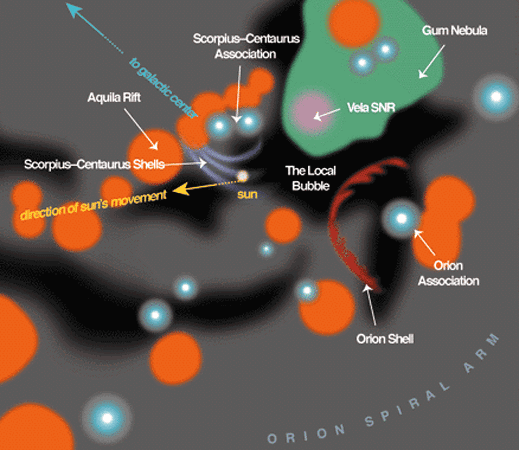It looks like you're using an Ad Blocker.
Please white-list or disable AboveTopSecret.com in your ad-blocking tool.
Thank you.
Some features of ATS will be disabled while you continue to use an ad-blocker.
share:
I’ve been following the publication of studies into the Geminga supernova for several years...it just kind of piqued my interest for one reason or
another. Anyway, I was revisiting it last night and it raised a couple of questions for me that I was hoping the bright and beautiful brains of ATS
could help me to explore.
First of all, a little about Geminga...

en.wikipedia.org...
It is believed that the explosion occurred roughly 340,000 years ago, give or take, at a distance of about 195 light years away from Earth. The supernova appeared in the Orion constellation between Betelgeuse and Ballatrix, where it could be seen for approximately two years before fading beyond visibility leaving only the gamma-ray trace that astronomical observers have since detected. Further investigations have suggested that at it’s peak, the explosion was bright enough to be perceived, from Earth, as a second sun during the day, and a second moon at night.
Quite the spectacular event by all accounts.
Thousands of years later though, the explosion itself hit us as an expanding wall of searing gases rushed past our solar system, and studies have shown that this may have destroyed up to 20 percent of the Earth’s high altitude ozone layer. This would have resulted in Earth being exposed to much higher levels of radiation both from the supernova itself and from the sun. This increase would not be sufficient to cause mass extinction evidently, but enough to effect the overall health of life on the planet, skin cancers cause by over exposure, cataracts and the such like. It most likely would have affected climate too, which raises my first question, could this explosion have had a direct effect on the subsequent glaciations of Earth? I have been unable though to find out exactly when that hit, having found reports from a variety of sources that differ greatly...anyone got any better information on that...without equations, I have a blind spot for those, eeek! I’m looking for plain English, or thereabouts, I can read scientific papers but so far, they have only confused me more.
Also of interest though is this ‘bubble’ thing.
discovermagazine.com...
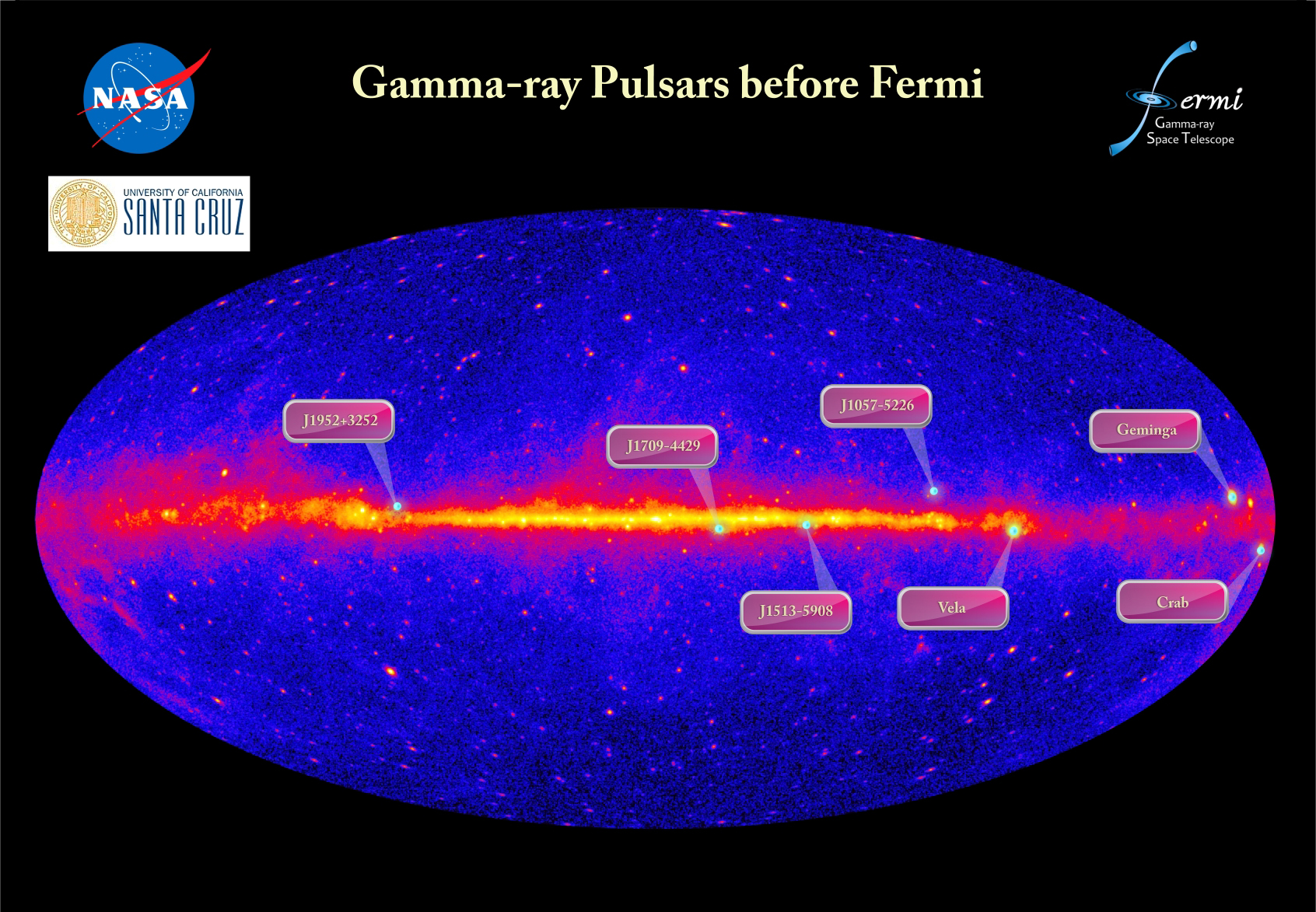
Now, from what I have been able to understand, the pulsar that Geminga created, spinning like a ‘light house’, emits a narrow beam of radiation which, since Earth is on it’s course, hits us with some frequency. So, my second question is, is this beam sufficiently intense to have any direct consequences on Earth, particularly in terms of effecting genetic mutations?
And on a somewhat less immediate level, the bubble, what consequences would that have, atmospherically, both locally and in terms of solar winds etc? Both as a result of it’s establishment, and of it’s subsequent demise in 600-700,000 years from now?
Anyone got any insight, or opinion on this event?
Many thanks in advance
First of all, a little about Geminga...

The nature of Geminga was quite unknown for 20 years after its discovery by NASA's Second Small Astronomy Satellite (SAS-2). Finally, in March 1991 the ROSAT satellite detected a periodicity of 0.237 seconds in soft x-ray emission. Thus, it is supposed that Geminga is a sort of neutron star: the decaying core of a massive star that exploded as a supernova about 300,000 years ago.[3]
This nearby explosion may be responsible for the low density of the interstellar medium in the immediate vicinity of the Solar System. This low-density area is known as the Local Bubble.[4] Possible evidence for this includes findings by the Arecibo Observatory that local micrometre-sized interstellar meteor particles appear to originate from its direction.[5]
en.wikipedia.org...
It is believed that the explosion occurred roughly 340,000 years ago, give or take, at a distance of about 195 light years away from Earth. The supernova appeared in the Orion constellation between Betelgeuse and Ballatrix, where it could be seen for approximately two years before fading beyond visibility leaving only the gamma-ray trace that astronomical observers have since detected. Further investigations have suggested that at it’s peak, the explosion was bright enough to be perceived, from Earth, as a second sun during the day, and a second moon at night.
Quite the spectacular event by all accounts.
Thousands of years later though, the explosion itself hit us as an expanding wall of searing gases rushed past our solar system, and studies have shown that this may have destroyed up to 20 percent of the Earth’s high altitude ozone layer. This would have resulted in Earth being exposed to much higher levels of radiation both from the supernova itself and from the sun. This increase would not be sufficient to cause mass extinction evidently, but enough to effect the overall health of life on the planet, skin cancers cause by over exposure, cataracts and the such like. It most likely would have affected climate too, which raises my first question, could this explosion have had a direct effect on the subsequent glaciations of Earth? I have been unable though to find out exactly when that hit, having found reports from a variety of sources that differ greatly...anyone got any better information on that...without equations, I have a blind spot for those, eeek! I’m looking for plain English, or thereabouts, I can read scientific papers but so far, they have only confused me more.
Also of interest though is this ‘bubble’ thing.
Two decades ago astronomers discovered that our solar system and a few thousand neighboring stars lie just inside a vast bubble, within which the thin gas of interstellar space is much thinner still--and also hotter. But in the years since that discovery, astronomers haven’t been able to explain the origin of what they’ve come to call the Local Bubble. Now they may finally have solved the mystery. The Local Bubble may be the remnant of a supernova that exploded roughly 300,000 years ago and less than 200 light-years away. Seen from Earth--and our hominid ancestors would very likely have seen it--that stellar catastrophe would have been as bright as the full moon.
The proposed solution to the Local Bubble mystery depended on, and came on the heels of, the resolution of another long-standing astronomical puzzle. Late in 1972, astronomers detected a powerful source of gamma rays, the most energetic form of electromagnetic radiation, in the constellation Gemini. Researchers tried to pin the gamma rays on some object they already knew--something that emitted X-rays, radio waves, or visible light--but for a long time they failed. Astronomers vented some of their frustration when they named the mysterious source, calling it Geminga, from an expression in Italian dialect meaning it’s not there.
Gehrels and his colleague Wan Chen have proposed that the supernova that gave birth to Geminga also created the Local Bubble. When Geminga’s parent star blew up, says Gehrels, the explosion cleared our neck of the galaxy of most interstellar gas and dust, creating a wind sock-shaped bubble some 600 light-years across. A supernova shock wave is like a snowplow pushing through the interstellar medium, pushing the more dense gas out, says Gehrels.
discovermagazine.com...

Now, from what I have been able to understand, the pulsar that Geminga created, spinning like a ‘light house’, emits a narrow beam of radiation which, since Earth is on it’s course, hits us with some frequency. So, my second question is, is this beam sufficiently intense to have any direct consequences on Earth, particularly in terms of effecting genetic mutations?
And on a somewhat less immediate level, the bubble, what consequences would that have, atmospherically, both locally and in terms of solar winds etc? Both as a result of it’s establishment, and of it’s subsequent demise in 600-700,000 years from now?
Anyone got any insight, or opinion on this event?
Many thanks in advance
Just to add, for the sake of argument...Just looking at this book...
www.amazon.co.uk...
...Ancient Egypt 39,000 BCE: The History, Technology and Philosophy of Civilisation X, by Edward F Malkowski, makes some pretty grand claims based on the somewhat exaggerated effects of the supernova and subsequent shockwave...it seems an interesting and diversionary read...so if anyone wants to check it out, parts of it can be read on Google books, it could spice up the discussion a little bit and part of what I am trying to ascertain he seems to be covering loosely, though how he reached those conclusions based on the limited information seemingly available doesn't seem clear. More than a little of 2 plus 2 makes 5, perhaps? Anyone's guess better than mine
www.amazon.co.uk...
...Ancient Egypt 39,000 BCE: The History, Technology and Philosophy of Civilisation X, by Edward F Malkowski, makes some pretty grand claims based on the somewhat exaggerated effects of the supernova and subsequent shockwave...it seems an interesting and diversionary read...so if anyone wants to check it out, parts of it can be read on Google books, it could spice up the discussion a little bit and part of what I am trying to ascertain he seems to be covering loosely, though how he reached those conclusions based on the limited information seemingly available doesn't seem clear. More than a little of 2 plus 2 makes 5, perhaps? Anyone's guess better than mine
Near earth? I suppose in the scope of the Universe it would be near earth. I just can't wrap my mind around something so far away being close.
This is very interesting information though.
This is very interesting information though.
edit on 14-1-2014 by rickymouse because: (no reason given)
reply to post by rickymouse
Sort of near to Earth then...to be precise a near-Earth event needs to be within a 100 light years distance, so Geminga is out a touch from that, but still, near enough to impact on us, if only visually. I perhaps shouldn't have said near Earth...an exaggeration on my part...
Thanks
Sort of near to Earth then...to be precise a near-Earth event needs to be within a 100 light years distance, so Geminga is out a touch from that, but still, near enough to impact on us, if only visually. I perhaps shouldn't have said near Earth...an exaggeration on my part...
Thanks
KilgoreTrout
reply to post by rickymouse
Sort of near to Earth then...to be precise a near-Earth event needs to be within a 100 light years distance, so Geminga is out a touch from that, but still, near enough to impact on us, if only visually. I perhaps shouldn't have said near Earth...an exaggeration on my part...
Thanks
The event did supposedly impact the earth no matter how far away it was though. So I suppose near earth is actually appropriate.
I wonder if we will be having something like this hit the earth in the next hundred years....would they tell us though, I doubt it. Chaos would erupt everywhere if they told us.
KilgoreTrout
So, my second question is, is this beam sufficiently intense to have any direct consequences on Earth, particularly in terms of effecting genetic mutations?
Nope. There are stronger extragalactic Gamma ray sources called Gamma Ray Bursts and they don't have any real effect either. Part of that is due to the inverse square law, the other part is due to atmospheric absorption....as seen here:
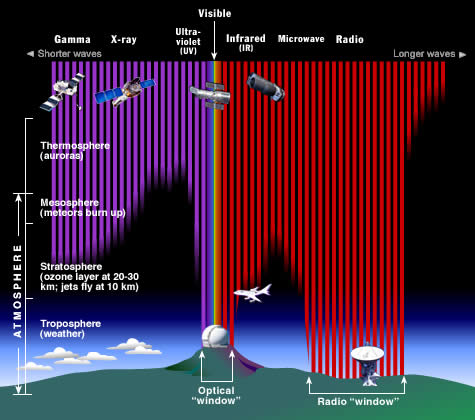
And on a somewhat less immediate level, the bubble, what consequences would that have, atmospherically, both locally and in terms of solar winds etc? Both as a result of it’s establishment, and of it’s subsequent demise in 600-700,000 years from now?
None really. What is being talked about in terms of a bubble is not some sort of "protective shell".
Anyone got any insight, or opinion on this event?
Many thanks in advance
The solar wind and heliosphere are many times stronger than this 'bubble'.
reply to post by JadeStar
JadeStar you little beauty...ta very much for that...BUT, what about the explosion and subsequent 'shock wave' itself? Could it really have destroyed 20% of the ozone layer, and if so, could the intensification of exposure, both in terms of the radiation from the supernova, but also due to more solar radiation being able to get through (and breathe...long sentence that)? If it could have caused severe sun burn, could it have caused genetic mutations??? And, climatic effects...maybe?
What do you think?
JadeStar you little beauty...ta very much for that...BUT, what about the explosion and subsequent 'shock wave' itself? Could it really have destroyed 20% of the ozone layer, and if so, could the intensification of exposure, both in terms of the radiation from the supernova, but also due to more solar radiation being able to get through (and breathe...long sentence that)? If it could have caused severe sun burn, could it have caused genetic mutations??? And, climatic effects...maybe?
What do you think?
rickymouse
I wonder if we will be having something like this hit the earth in the next hundred years....would they tell us though, I doubt it. Chaos would erupt everywhere if they told us.
On average, a supernova explosion occurs within 10 parsecs (33 light-years) of the Earth every 240 million years. Gamma rays are responsible for most of the adverse effects a supernova can have on a living terrestrial planet. In Earth's case, gamma rays induce a chemical reaction in the upper atmosphere, converting molecular nitrogen into nitrogen oxides, depleting the ozone layer enough to expose the surface to harmful solar and cosmic radiation. Phytoplankton and reef communities would be particularly affected, which could severely deplete the base of the marine food chain.[2][3]
en.wikipedia.org...
I think it is a bit like when a big comet is about to hit...our best bet is to make like the smaller mammals and dig ourselves a nice deep burrow
That claim doesn't exactly match up with 12.9 km/s shockwave measurement from a supernova, which traveling at that velocity for 195 light years would take about 4.5 million years to reach Earth.
KilgoreTrout
Thousands of years later though, the explosion itself hit us as an expanding wall of searing gases rushed past our solar system, and studies have shown that this may have destroyed up to 20 percent of the Earth’s high altitude ozone layer.
Precisely measuring velocity of a supernova shock wave
So what this tells us is that the shock wave would have had to travel a lot faster than that to reach Earth in thousands of years instead of millions of years. Is that possible? Certainly the initial shock wave velocity is much higher within a few light years of the supernova. You said you don't like equations but there is one, however it depends on the initial energy and the density of the surrounding interstellar medium. If the latter is unknown prior to the Geminga supernova, then we can't complete the calculations with the equation unless we estimate (guess?). Since that density is about 10 times higher outside the bubbles, that would be one guess.
The analysis shows that the expansion velocity of the W44 shock wave is 8.0 ± 0.1 miles per second (12.9 ± 0.2 km).
My bottom line take is that the article you cited about Geminga clearing the local bubble is from 1993, and the article with the measured velocity of the supernova shock wave is from 2013, which is information Gehrels and Chen didn't have access to in 1993 (though they had theoretical models), and moreover they only said that the local bubble MIGHT HAVE been caused by the Geminga supernova. Did you read the abstract of their paper? It's got a lot of "if's" in it.
I think this summary by astronomer David Darling may put it in perspective:
www.daviddarling.info...
Note he says "explosions" as in plural, meaning Geminga may not be the only one and isn't the only candidate, though it is a prime candidate. Also notice the age estimate extends into possible millions of years, so I think your question about how many thousands of years it took the shock wave to strike Earth is a bit optimistic. There may have been other supernovae besides Geminga involved in creating the local bubble and apparently we aren't even really sure about Geminga though it does seem to be a good possibility.
observations have led astronomers to conclude that the Bubble was formed between a few hundred thousand and a few million years ago by several relatively nearby supernova explosions that pushed aside gas and dust in the ISM leaving the current depleted expanse of hot, low density material. A prime suspect for an object left behind by this supernova activity is Geminga.
Here's an illustration of the local bubble, which doesn't even show Geminga:
apod.nasa.gov...
You are apparently also thinking along these lines of what local astronomical observations may suggest about Earth's past climate, and it's certainly an interesting question. I think many of the answers are yet to come.
...Future observations should help astronomers discern more about the local Galactic Neighborhood and how it might have affected Earth's past climate.
One more map and this one DOES show Geminga:
apod.nasa.gov...

Look at all the new pulsars found in this image published in 2009. Apparently Gehrels and Chen didn't know about all those in 1993 either. This may support David Darling's idea that maybe the local bubble was formed by more than one supernova.
KilgoreTrout
reply to post by JadeStar
JadeStar you little beauty...ta very much for that...BUT, what about the explosion and subsequent 'shock wave' itself? Could it really have destroyed 20% of the ozone layer,
Possibly. But the thing to remember here is that the ozone layer is constantly replenished. Think about what ozone is for a second. It's 3 oxygen atoms joined together. Ozone is produced by a number of things which occur naturally.
The simplest way to explain it is like this, regular oxygen (O2) is floating around up there, and will sometimes get hit by a ray of UltraViolet (UV) light that is "just right" or pounded by a high-energy electron from the Sun that knocks it in two, creating instead of O2, just O and O.
The simple O is very reactive, they're like teenage boys, they're always looking for a partner and will grab on to a normal O2 molecule when it hits one, forming O3, which is ozone. It's because of this rather unusual structure that ozone, O3, can "block" ultraviolet light for us.
Ozone is also produced every time there is a lighting strike anywhere on Earth.
So next time you are out after a lightning storm take a deep breath and realize you're breathing in some O3 (Ozone) as well as O2 (Oxygen).
and if so, could the intensification of exposure, both in terms of the radiation from the supernova, but also due to more solar radiation being able to get through (and breathe...long sentence that)? If it could have caused severe sun burn, could it have caused genetic mutations??? And, climatic effects...maybe?
A 20 percent reduction in the ozone layer would not have had the doomy effect you're thinking about here.
Think about it, we've caused a greater loss in Ozone over the Antarctic through the use of CFCs than this event would have caused.
In 1984, when the a British team in Antarctica which discovered the Ozone "hole" there, first reported their findings, Ozone levels were about 35 percent lower than the average for the 1960s. When the first measurements were taken the drop in Ozone levels in the stratosphere was so dramatic that at first the scientists thought their instruments were faulty.
Yet, we've seen no mutation in the species that live in Antarctica due to this drop. We'd have to lose around 50%-65% of the Ozone layer for there to be any such concern.
What do you think?
I think there are far more scary things to be worried about than gamma ray pulsars. Some of them even produce gamma rays. Most of those scary things are on Earth.
edit on 14-1-2014 by JadeStar because: (no reason given)
Arbitrageur
One more map and this one DOES show Geminga:
apod.nasa.gov...

Look at all the new pulsars found in this image published in 2009. Apparently Gehrels and Chen didn't know about all those in 1993 either. This may support David Darling's idea that maybe the local bubble was formed by more than one supernova.
That's a radio pulsar map. Its a radio map of the sky. Not gamma rays.
Here is a better map:
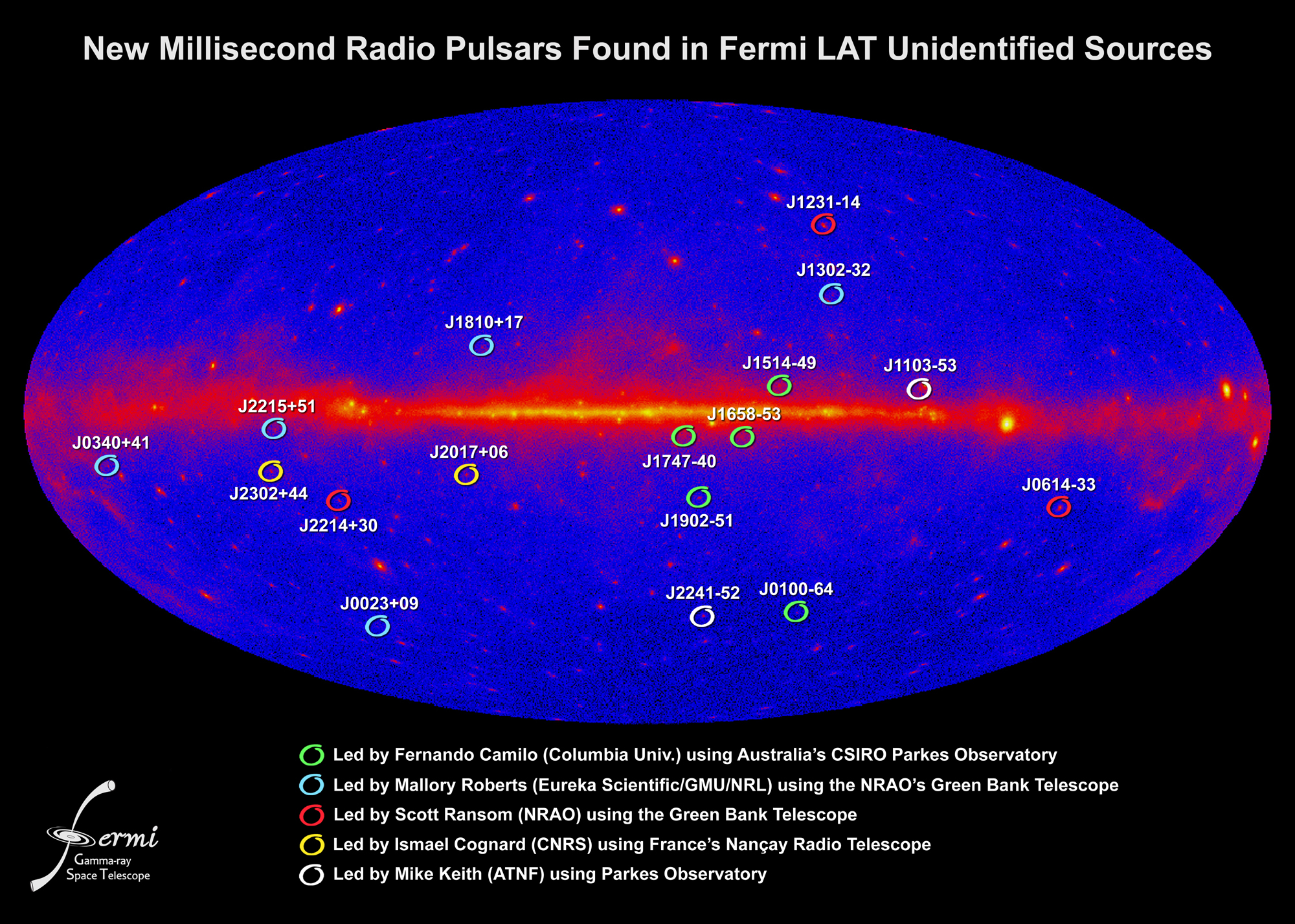
The circled point sources on them are gamma ray pulsars, a special kind of pulsar. They're shown on the context of a radio map so people can see the correlation between radio pulsar and gamma ray pulsar sources.
In Astronomy, context is everything. And understanding that context does a lot to debunk doom sellers. Because most doom sellers count on people not knowing much about astronomy, the sky, different types of electromagnetic or ionizing radiation, the interstellar medium, etc.
Half of the doom sellers probably don't either.
Deny Ignorance. Always.
edit on 14-1-2014 by JadeStar because: (no reason given)
reply to post by Arbitrageur
Fantastic reply, thank you. A lot for me to digest...I may be back later with some further questions
Loving the idea of the 'Local Fluff Complex'
Fantastic reply, thank you. A lot for me to digest...I may be back later with some further questions
Loving the idea of the 'Local Fluff Complex'
reply to post by JadeStar
Another great reply, thanks. I'm getting a good education here, just as I knew that I would.
I'm not scared incidently, nor gloomily inclined. I was thinking more in terms of genetic level mutations, much in the same sense of exposing seeds to mutagenising chemicals in order to bring to the forefront certain characteristics.
Since you mention thunderstorms...I am sure I read somewhere that supernova, much like thunderstorms, converts nitrogen particles to nitrogen oxide...I can see that as being a beneficial thing since very,very few lifeforms have the ability to do that. Or am I misunderstanding that?
Another great reply, thanks. I'm getting a good education here, just as I knew that I would.
I'm not scared incidently, nor gloomily inclined. I was thinking more in terms of genetic level mutations, much in the same sense of exposing seeds to mutagenising chemicals in order to bring to the forefront certain characteristics.
Since you mention thunderstorms...I am sure I read somewhere that supernova, much like thunderstorms, converts nitrogen particles to nitrogen oxide...I can see that as being a beneficial thing since very,very few lifeforms have the ability to do that. Or am I misunderstanding that?
Yes there are gamma ray pulsars on that map (in addition to radio pulsars). Did you read the caption? The radio pulsars are circled in magenta, but the gamma ray pulsars are circled in yellow:
JadeStar
Arbitrageur
One more map and this one DOES show Geminga:
apod.nasa.gov...

Look at all the new pulsars found in this image published in 2009. Apparently Gehrels and Chen didn't know about all those in 1993 either. This may support David Darling's idea that maybe the local bubble was formed by more than one supernova.
That's a radio pulsar map. Its a radio map of the sky. Not gamma rays.
Born in supernovae, pulsars are spinning neutron stars, collapsed stellar cores left from the death explosions of massive stars. Traditionally identified and studied by observing their regular radio pulsations, two dozen pulsars have now been detected at extreme gamma-ray energies by the Fermi Gamma-ray Space Telescope. The detections include 16 pulsars identified by their pulsed gamma-ray emission alone. This gamma-ray all-sky map, aligned with the plane of our Milky Way Galaxy, shows the pulsar positions, with the 16 new Fermi pulsars circled in yellow (8 previously known radio pulsars are in magenta).
edit on 14-1-2014 by Arbitrageur because: clarification
KilgoreTrout
reply to post by JadeStar
Since you mention thunderstorms...I am sure I read somewhere that supernova, much like thunderstorms, converts nitrogen particles to nitrogen oxide...I can see that as being a beneficial thing since very,very few lifeforms have the ability to do that. Or am I misunderstanding that?
No you're not. But it is more commonly created the same way ozone is from lightning and charged particles from the sun. The major natural source of it is lightning.
Supernovas DO have an important role to play in terms of being beneficial to life.
Every element heavier than hydrogen was created in the core of a star and thrown out into space at the deaths of massive stars by supernova explosions billions of years ago. This process is ongoing today albeit at a slower rate.
Where there is death, there are the seeds of new life.
As above. So below.
Your body, your family, your house, your car, this planet, this solar system owes it self to many supernova going off because had they not then things like carbon, oxygen, nitrogen, iron, silica, would not exist.
Nor would you or I.
edit on 14-1-2014 by JadeStar because: (no reason given)
edit on 14-1-2014 by JadeStar because: (no reason given)
JadeStar
Where there is death, there are the seeds of new life.
Hence why I see no point in getting all gloomy about such stuff
Thanks so much for helping me to get my head around this.
Okay...so, all this considered, how about the 'second sun'/'second moon' aspect? How accurate is that?
KilgoreTrout
Okay...so, all this considered, how about the 'second sun'/'second moon' aspect? How accurate is that?
Well to sum that up data from WISE (Wide-field Infrared Survey Explorer) has ruled out any dim red dwarf or brown dwarf companion to our Sun. So we do not live in a binary star system.
As for a second moon, there is only one natural satellite that revolves around the Earth, our Moon however in recent years we've discovered a class of asteroid called Earth trojans. These are objects which share the orbit of the earth and have been called "second moons" of Earth by some in the popular press.
Here are a couple....
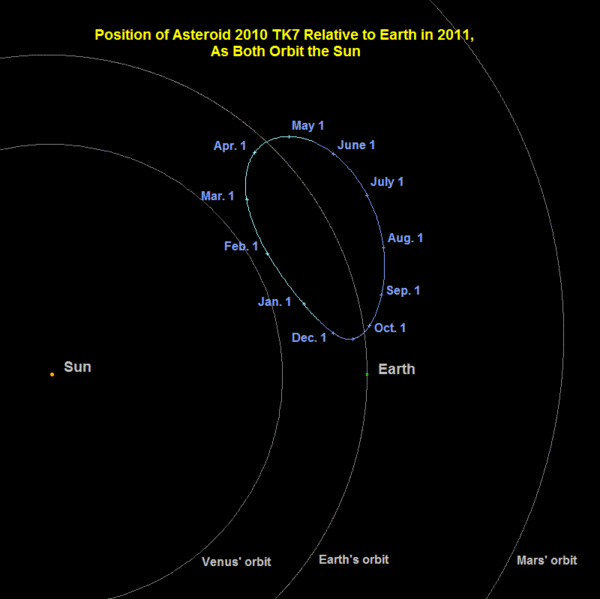
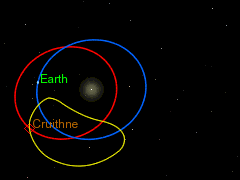
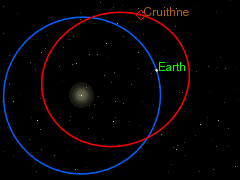
reply to post by JadeStar
I think the OP was referring to the claim that the Geminga supernova explosion was as bright as a "second sun" or "second moon". Any thoughts on that?
By the way, fascinating thread, S&F for that.
Wiki for "Local Bubble" says:
en.wikipedia.org...
I also find it interesting that this hot diffuse gas in the Bubble emits X-rays.
I'll echo earlier posts that the environment caused by the Sun in the Solar System is much stronger and denser than the Local Bubble. There might have been some interaction with the heliosphere (where the solar wind meets interstellar medium).
I think the OP was referring to the claim that the Geminga supernova explosion was as bright as a "second sun" or "second moon". Any thoughts on that?
By the way, fascinating thread, S&F for that.
Wiki for "Local Bubble" says:
The very sparse, hot gas of the Local Bubble is the result of supernovae that exploded within the past ten to twenty million years. It was once thought that the most likely candidate for the remains of this supernova was Geminga ("Gemini gamma-ray source"), a pulsar in the constellation Gemini. More recently, however, it has been suggested that multiple supernovae in subgroup B1 of the Pleiades moving group were more likely responsible.
en.wikipedia.org...
I also find it interesting that this hot diffuse gas in the Bubble emits X-rays.
I'll echo earlier posts that the environment caused by the Sun in the Solar System is much stronger and denser than the Local Bubble. There might have been some interaction with the heliosphere (where the solar wind meets interstellar medium).
wildespace
reply to post by JadeStar
I think the OP was referring to the claim that the Geminga supernova explosion was as bright as a "second sun" or "second moon". Any thoughts on that?
That sounds accurate. The brightness and relative closeness of it would have made it visible in the daytime sky.
new topics
-
My take on early 90's classic-maybe relevant to the election
The Gray Area: 25 minutes ago -
Understanding the likelihood of simulation theory by referring to AI and highly cogent dream states
Philosophy and Metaphysics: 51 minutes ago -
Interesting - anti-Christian bias task force proposed
2024 Elections: 1 hours ago -
Mastering 'the art of brainwashing,' China intensifies AI censorship
Other Current Events: 1 hours ago -
Hilarious spoof ad mocks Kamala Harris
Jokes, Puns, & Pranks: 2 hours ago -
"March for the Freedom for Britain" - Trafalgar Square London - Live
Regional Politics: 3 hours ago -
In four years, you don’t have to vote again.
2024 Elections: 5 hours ago -
Prize or Zonk
General Chit Chat: 8 hours ago -
I've realized something about Politics recently.
US Political Madness: 9 hours ago -
France bans head coverings but allows Christianity to be mocked at Olympics.
Political Conspiracies: 11 hours ago
top topics
-
Hilarious spoof ad mocks Kamala Harris
Jokes, Puns, & Pranks: 2 hours ago, 17 flags -
The Main Question and A Bonus Question
General Conspiracies: 17 hours ago, 13 flags -
Is Kamala Good for America ?
Political Issues: 17 hours ago, 12 flags -
BIDEN-HARRIS Preparing to Also Make Us Pay For Illegal-Aliens to Attend College Prep Programs.
Political Ideology: 15 hours ago, 10 flags -
In four years, you don’t have to vote again.
2024 Elections: 5 hours ago, 9 flags -
The Most Crime Ridden Games Ever
World Sports: 17 hours ago, 6 flags -
Interesting - anti-Christian bias task force proposed
2024 Elections: 1 hours ago, 5 flags -
France bans head coverings but allows Christianity to be mocked at Olympics.
Political Conspiracies: 11 hours ago, 5 flags -
I've realized something about Politics recently.
US Political Madness: 9 hours ago, 4 flags -
"March for the Freedom for Britain" - Trafalgar Square London - Live
Regional Politics: 3 hours ago, 3 flags
active topics
-
The World Is Not Being Run By Human Beings
Aliens and UFOs • 42 • : All Seeing Eye -
In four years, you don’t have to vote again.
2024 Elections • 51 • : ADVISOR -
Mastering 'the art of brainwashing,' China intensifies AI censorship
Other Current Events • 5 • : asabuvsobelow -
bots ruining internet or are these actually people guys i dont know
General Chit Chat • 36 • : mysterioustranger -
"March for the Freedom for Britain" - Trafalgar Square London - Live
Regional Politics • 2 • : gortex -
My take on early 90's classic-maybe relevant to the election
The Gray Area • 2 • : norhoc4 -
Russian vacation killing Somali Pirates
Other Current Events • 23 • : andy06shake -
The Most Crime Ridden Games Ever
World Sports • 11 • : F2d5thCavv2 -
France bans head coverings but allows Christianity to be mocked at Olympics.
Political Conspiracies • 37 • : bastion -
Interesting - anti-Christian bias task force proposed
2024 Elections • 2 • : worldstarcountry

